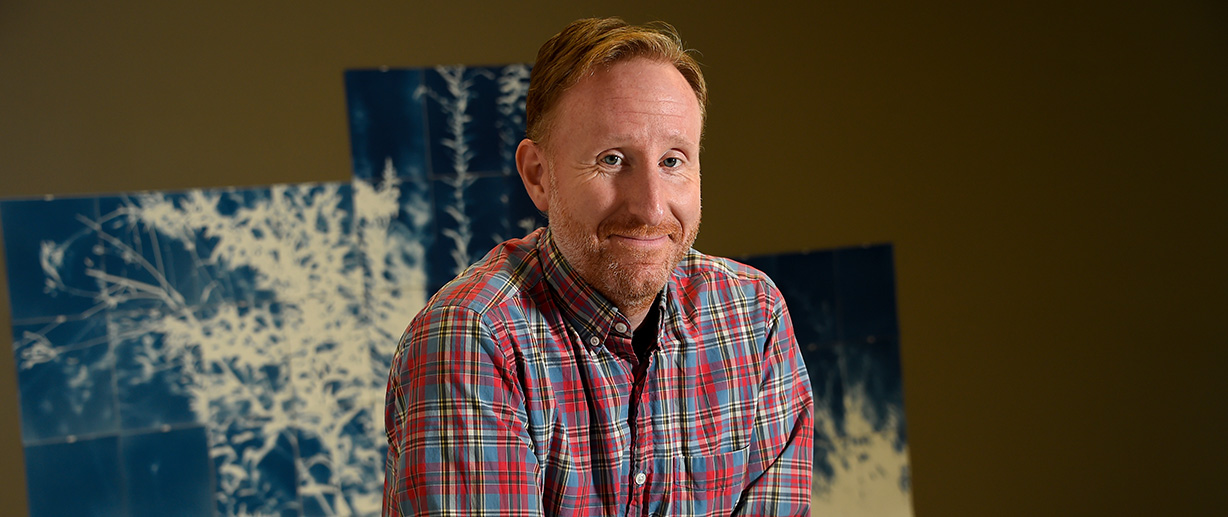On the first day of class, Eric Carroll told his digital photography students that they’ve probably taken more photos than him thanks to their early exposure to smartphones. But their exposure to the class would expand their understanding of photography.
Carroll is Wofford’s first Goodall Visiting Fellow. He fuses his love for photography, science and nature in the course while also giving students a glimpse of how he finds work as an artist.
“I’m very interested in how photography helps us understand the world and establishing truths,” Carroll says.
Carroll is at Wofford for the fall semester after spending 10 years as an assistant professor of art at Macalester College in St. Paul, Minnesota.
One of his favorite photographic approaches is cyanotype, a photographic and printing process that dates to 1842.
Carroll will teach a cyanotype workshop from 1-3 p.m. on Oct. 30 at Wofford’s Goodall Center for Environmental Studies in Glendale. Register here for the free event. He’ll participate in an artist’s talk at 5 p.m. on Nov. 15 in Olin 101.
Carroll’s work has been on exhibit across the United States, and he’s the author of four photography books.
The Goodall Visiting Fellowship is a semester-long residency designed to give people an opportunity to pursue their creative practices while engaging with the Wofford and Glendale communities. It offers two-week and semester-long opportunities to engage with Wofford’s Long-Term Environmental Reflection project at Glendale Shoals Preserve. The fellowship opportunities were endowed by Chris Goodall ’79, a former Wofford trustee, to allow the college to expand and formalize opportunities for visiting artists, writers and interdisciplinary scholars.
Carroll has found Glendale to be a special outdoor classroom.
Glendale is a small community in Spartanburg County that was built along the Old Georgia Road, a trading path during the Revolutionary War era. It has the ruins from a historic textile mill along Lawson’s Fork Creek. Wofford owns four acres in the community and has access to more than 200 adjacent acres through community partners, including the Tyger River Foundation and the Spartanburg Area Conservancy. The college has a vineyard, a garden and an amphitheater in Glendale, as well as the historic office for the mill, which was renovated in 2009 to serve as the focal point for the environmental studies department and a resource for the Wofford community.
“It’s an important time to take photos there,” Carroll says. “As I tell my students, you’re not just shooting art, but you’re documenting history. Every time I’m out there, I see someone taking photographs. It’s a naturally photogenic space. This is a safe space that is just as legitimate as a classroom.”
Cyanotype often involves foraging and collecting flowers and clippings from plants, and Carroll places additional emphasis on ensuring that plants are not damaged in the process. The workshop in Glendale will be like ones that he’s led from his backyard in Asheville, North Carolina, that have had participants ranging from 10 to 80 years old.
“I teach cyanotype to teach where the medium (photography) came from,” Carroll says. “We’re mixing chemistry and printing images from phones. These are two technologies that are 200 years apart.”
Carroll enjoys when art and science collide in photographs.
“I like trying to determine whether photos were made for a scientific or artistic purpose,” says Carroll, who is a fan of images of galaxies captured by NASA’s James Webb Telescope.
The COVID-19 pandemic led Carroll and his wife to rethink life. He grew up in the Midwest and she’s from South Carolina. They thought it’d be nice to relocate to the South and they moved to Asheville. He also wanted to focus more on his art. He met Dr. Kaye Savage, environmental studies professor and director of the Goodall Environmental Studies Center, through a photography collective online, and that led him to apply for the visiting fellowship.
After fall break, Carroll and his students will focus on taking portraits.
“We’re going to break down assumptions about the medium,” Carroll says. “Why do you smile and pose when a camera is pulled out? We’ll take self-portraits and discuss how we respond when being photographed for an ID badge or a selfie.”
